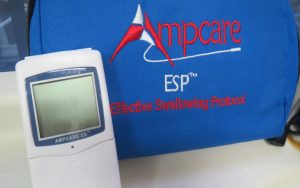Swallowing Treatment
Speech therapist for patients with swallowing disorders
Provides assessment and a range of treatments.
Stroke, brain trauma, Parkinson's disease, dementia, aging, etc. can all cause swallowing disorders.
Swallowing disorders can lead to serious consequences, such as aspiration pneumonia, and in severe cases, death.


Common symptoms:
- Coughing, wheezing, or frequent need to clear throat when eating
- Requires several swallows to swallow food
- Keeping food in your mouth often and taking too long to eat
- Food remaining in the mouth after eating
- Frequent drooling and food coming out of the mouth or nostrils
- Food seems to be stuck in the throat or esophagus when eating
- Voice becomes cloudy and unclear after swallowing
- Frequently suffer from aspiration pneumonia or fever
- Weight loss and dehydration
評估
The swallowing assessment methods performed by therapists include: clinical assessment, X-ray swallowing examination (Videofluoroscopic Swallowing Study) and endoscopic swallowing examination (Fiberoptic Endoscopic Evaluation of Swallowing).

1. Clinical evaluation
The therapist makes a diagnosis by observing the patient's oral function and eating habits. The therapist will invite the patient to eat food or drinks of different consistencies to observe whether the patient has symptoms of dysphagia.
2. X-ray swallowing examination
The therapist observes the patient's swallowing process from the mouth to the esophagus under X-rays. The therapist will invite the patient to eat food and drinks containing barium during the examination, then determine the cause of the patient's dysphagia and his swallowing ability, and provide corresponding eating suggestions. The therapist may also try different eating compensation strategies during the examination, such as changing eating postures.
3. Endoscopic swallowing examination
The therapist will work with a specialist to perform this swallowing exam. The endoscope will enter the patient's throat through the nostrils. The therapist will observe the structure and function of the patient's swallowing muscles through real-time images. The therapist will also invite the patient to eat different pigmented foods to determine the cause of the patient's dysphagia and his/her swallowing ability. ability.
Treatment
The therapist will provide targeted swallowing treatment based on the patient’s swallowing condition.
- Change food texture and liquid consistency
- Change eating posture
- Safe feeding tips
- Deep pharyngeal muscle nerve stimulation method
- Electrotherapy (Guardian Way®, Ampcare ESPTMT, VitalStim®)
- MDTP treatment
- Myofascial Release manual therapy
- Swallowing muscle movement

Three areas of rehabilitation in a New Page
Prevention
- Provide preventive services to institutions or institutions
- Reduce the risk of choking while eating
- Reduce the frequency of hospitalization for the elderly
Remediation
- Provide professional assessment and diagnosis for institutions or institutions
- Individual or group therapy available
- After completing the assessment, the therapist will provide each elder with free individual safe feeding guidelines
Enhancement
- Enhancing family members and nursing staff to master safe feeding skills
- Improve the communication skills of residents
- Increase the joy of eating in life


